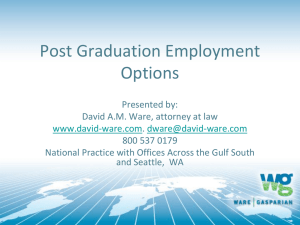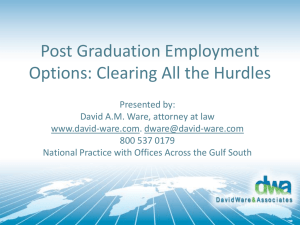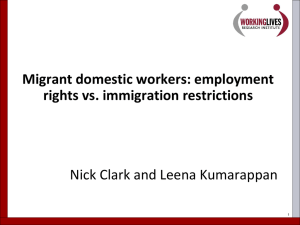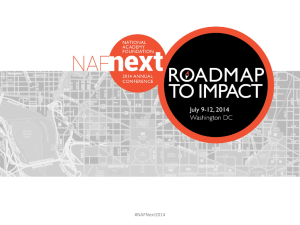Post Graduation Employment Options: Clearing All
advertisement
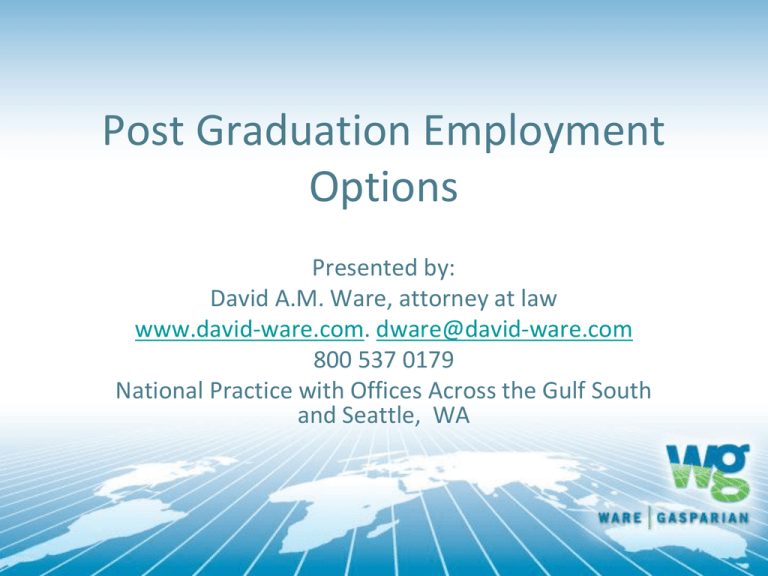
Post Graduation Employment Options Presented by: David A.M. Ware, attorney at law www.david-ware.com. dware@david-ware.com 800 537 0179 National Practice with Offices Across the Gulf South and Seattle, WA General Matters • WARNING: This presentation provides general information only and cannot substitute for individualized legal advice about your particular case. In the world of immigration, very small factual differences can make a huge difference in your case. • In order to receive such advice consult our firm individually or seek a qualified immigration attorney of your choice. General Matters • DON’T get advice from friends or relatives. • ONLY get advice from your international office or a qualified, experienced immigration attorney. • NEVER consult a non attorney who does not work in the international office for immigration advice (including your academic advisor or a notario). • ALWAYS follow the advice of your international office. Where Do I Start? • Your career in the US after graduation should ALWAYS start with Optional Practical Training (OPT). OPT acts as a vital bridge between your studies and the workplace. • If you miss OPT, you will have very hard time penetrating US job market. • It allows you to “get your foot in the door” with a US employer without any paperwork on their part: vitally important. • It allows you to try more than one job if you wish. • Go to OPT workshops and follow OISS instructions!! Can I Skip A Step? • While in some cases it may be possible to proceed directly to H1B or even permanent residence without OPT, this is usually unadvisable, as the H1B could be denied, and permanent residence almost always takes more than one year. • So, generally you will proceed like this: – – – – Complete course(s) of study Do OPT Move onto H1B or other work visa Obtain Permanent Residence (PR). After OPT: The Next Step: H1B • H1B is the principal immigration status available for persons temporarily working in professional level jobs (“specialty occupations”) in the US. • Who sponsors? www.immihelp.com/h1b-sponsoringcompanies-database/ • It generally requires that the employee have at least a four year degree or equivalent AND that the position require a minimum of a bachelor’s degree. • So, for example, engineer, accountant, yes; store clerk, cook, secretary, no. What Are the Parameters of H1B? • Employment is limited to the employer(s) who petition(s) for the student. May hold more than one H1B at same time. H1B may be part time. • Employment is generally limited to six years with ALL employers (unless employment-based permanent residence begun by end of 5th year). • Employment must be directly related to degree program— either current program or any prior degree program. • H1B’s are limited by strict fiscal year quotas. Federal FY = 10/1 to 9/30 each year. • The H1B beneficiary may have “dual intent”. What Are the Employer’s Obligations? • Must agree to employ beneficiary as set out in the petition (no fraud!). • Must need the services of the employee: there must be a rational nexus between the size and nature of the employer and the job you will do. • Must agree to employ H1B only in geographic location(s) set out in labor condition application. • Must agree to pay return transportation to country of nationality if H1B terminated before end of visa petition approval. Employer’s Wage Obligation • Must agree to pay higher of actual or prevailing wage (aka “required wage”). – Actual wage: wage paid to other similarly employed and similarly qualified workers at same worksite. – Prevailing wage: weighted mean or median wages for similar positions in geographic area of employment. – Basically, this means that a competitive wage must be offered. – There are four levels of wages and separate wage data for higher ed and certain other employers. See: • www.flcdatacenter.com/oeswizardstart.aspx Employer’s Obligations? • Must be no strike or lockout (unionized jobs). • Must notify other workers of terms of job (two 10 day postings or letter to union). • Should agree to pay filing fees to USCIS (next slide) and attorney’s fees. What Are the Fees? • • • • • • Regular filing fee: $325 Fraud fee: $500 ACWIA fee: $1500 (26 or more FTE’s) $750 Filing fee for dependants: $290 Premium fee: $1225 (15 day processing) Attorney’s fees: vary widely: no standard amount. Who Pays for What? • Except for ACWIA fee, until recently, there was no hard and fast rule. • A series of judicial decisions now makes clear that the employer must pay all costs and fees required to get the employee on the payroll. • Employer could incur huge liabilities if they don’t pay. • What to do if they don’t want to pay? Have them discuss issue with experienced immigration attorney. • Note: employer not responsible for dependants, • Employer not responsible for premium fee if needed by employee for personal reasons, eg, personal travel. What’s Filed and When? • First is Labor Condition Application. Filed electronically with Department of Labor. Takes about five to ten business days to be approved. • Next is H1B Petition, together with LCA, evidence of qualifications, and description of job, filed at either VT or CA Service Center of USCIS, depending on place of employment, or CA if quota exempt. • If employee maintaining lawful status in US, status is changed to H1B, along with family members. • If outside US, or traveling following change of status, must obtain H1B visa at US consulate, unless going for 30 days or less to Canada/Mexico. Canadians are visa exempt. The Magic Approval • Processing of the H generally takes three to seven months. Fifteen day premium processing is available for $1,225; PP also guarantees easier communication with USCIS via phone/email. • Once approved, the H employee may “port” to a new employer once that employer files a new petition. Approval of new petition is not necessary to “port”. BEWARE: “porting” is difficult if you have not been counted against the quota. Any Problems with the H Visa? • How many H visas are made available? – Currently H1B’s are limited to about 78,200 per fiscal year. ~58,200 for those with no US earned Master’s. --20,000 for those with US earned Master’s or higher. ~6,800 reserved for H1B1 for citizens of Chile, Singapore. The H1B Quota Filing Season • Quota subject petitions (most private employers SHOULD, if possible, be filed on April 1 or first business day thereafter. • There may be quota numbers after that date but no guarantee. • Quota subject petitions will always have start date of October 1 (first day of federal fiscal year). Quota History • In 2008, USCIS accepted H petitions for five business days beginning April 1 and all cases received put into a lottery. • All 78,200 numbers were exhausted. • In 2009: same system, but about 20,000 visas left at end of process. • Both regular and Master’s quotas exhausted 12/21/09. • In 2010: On December 24, 2010 the Master’s quota was met and by January 26, 2011 the regular quota was met as well. • In 2011: Master’s quota, October 19; regular quota November 22. • New quota opened April 2 for employment to begin October 1. • Master’s quota exhausted June 7, 2012. Regular quota, June 11. • Recent news: Has USCIS been undercounting? Who’s Exempt from Quota? • Exempt from the quota are – Persons already counted against it within past six years. – persons who work in higher ed and affiliated nonprofit entities. – Those who work “at” rather than for a quota exempt employer – Employees of non profit research and government research organizations. Note that most government entities and non profits are NOT exempt from quota. – J 1 physicians granted a waiver of the two year home residence requirement. – Persons engaged in concurrent quota exempt/quota subject jobs also exempt. So Called “cap gap” OPT • In April, 2008, in order to assist students caught by the H1B quota, USCIS created so called “cap gap” protection which automatically extends OPT and F status through September 30 of any year, if: – The student’s employer properly filed an H1B petition on his/her behalf prior to the expiration of his/her OPT (which must end on or after April 1); – The H1B petition shows a start date of October 1. – Cap gap OPT ends midnight September 30. -- If the H petition is filed during the student’s grace period, after expiration of OPT, then the “cap gap” extends status only, but not work authorization. • In order to fully document the “cap gap”, the student should seek a “cap gap” I 20 from the school. Travel While In “Cap Gap” • You should not travel while in the cap gap as you will have no valid EAD card. Reentry to the US on OPT generally requires: – – – – I 20 endorsed for travel Valid passport and F 1 visa (unless visa exempt) Valid EAD card Employment letter Cap Gap Example • Maria’s OPT will end May 15, 2013. • Her employer will file an H petition for her on April 1, with a start date of October 1, 2013 (the earliest date that can be requested). • Maria’s F status and OPT will automatically be extended to midnight, September 30, 2013. • She may (but does not have to) request a “cap gap” I-20 from her school. • What if Maria’s OPT will end on March 15, 2013? • What happens if Maria’s H1B is not approved by midnight September 30? Employers’ Many Misconceptions • Employer believes that it must recruit, prove American workers not available, or prove that student is exceptional, special, or unique in order to sponsor. • FALSE: No recruitment required. Special qualities not required. Two ten day postings or letter to union are for notification only. Misconceptions—Trouble, Money • Employer thinks the process “will get them in trouble with immigration” (not unless they have otherwise shady practices or lie in the paperwork). • Employer doesn’t want to reveal financial information to USCIS: in the H1B context financial info almost never needed. If so, does not have to be revealed to employee. Misconceptions--Paperwork, Salary • Employer thinks “it’s too much trouble, paperwork” (a few signatures, two ten day postings, no advertising; attorney can simplify process). • Employer worries about posting the employee’s wage (post a range!). Misconceptions—”Contract”? • Employer worries that sponsorship may constitute contract of employment (no, but if they’re worried, do a memo of understanding both sign). • Employer worries that employee is later going to ask for PR and leave the company –they’ve been burned before (Sign a “one way” contract; employee has to repay legal fees if leaves before a certain date; but employer retains right to “employ at will”). What About Starting My Own Business and H? • To be an H1B employer, an entity usually must have at least one employee other than the H1B. Very difficult to get a “self employed” H petition approved (despite Obama’s promises). Also, difficult for new company to pay salary. • Usually not a wise idea to start your own business, unless you have loads of money (at least 500K to 1 million) or qualify for investor visa (treaty required— we will discuss later). • Why not? Generally, business owners cannot sponsor themselves for permanent residence. • Consider E, O or L instead of H (see below). Are There Alternatives to the H? • TN (Treaty NAFTA) for citizens of Canada and Mexico only. Occupations listed at 8 Code of Federal Regulations Sec. 214.6(c) mostly require a minimum of Bachelor’s degree, except Scientific Technician/Technologist. But business majors beware: “Management Consultant” is carefully scrutinized; generally must be independent contractor. TN given in three year increments; requires residence abroad (no dual intent). Other Alternatives? • H1B1 visa for Chile, Singapore: very similar to normal H1B, except granted in one year increments, requires residence abroad (no dual intent). • E 3 for Australian citizens; again very similar to H1B; two year increments; minimum Bachelor’s, dual intent ok; spouses may work. • H-3 trainee. 2 yrs max; training must be for job abroad. • J-1 trainee. 18 mo. max; looser than H 3, but requires fgn degree and one year work experience in field outside US. • J-1 professor/researcher , K-12 teacher, camp counselor, summer work/travel, specialist, short term scholar, etc. • O-1 person of extraordinary ability/achievement. H Alternatives? • E 1/E 2: if your country of nationality has an trader/investor treaty with US, investment of as little as 50K in a job-creating business can mean a visa for life, work permit for spouse. • List of treaty countries: http://travel.state.gov/visa/fees/fees_3726.html • L 1A/L 1B: if you were employed by a company abroad for at least a year before coming to the US, and they wish to employ you in US; work permit for spouse. • R-1: possible if job offer has a significant religious component. • B-1 business visitor: only possible if employed outside US, no remuneration in US except expenses, and product/service is made/rendered outside US. VERY LIMITED UTILITY. What If No Job Offer in US? • Go back to school, retool your skills to fit the market. • Canada, Australia or other country with demand for your skills are alternatives. • Canada has an easy point system. See cic.gc.ca. • Your home country or other country where your language is spoken/your skills are in demand. Many companies, eg, Johnson and Johnson, eagerly hire for home country service, and then often transfer back to the US. Permanent Residence What is Permanent Residence? • The right to live and work permanently in the US for any employer. • A person becomes a permanent resident through adjustment of status in the US or issuance of an immigrant visa outside the US. A person generally must maintain lawful status in order to adjust in the US. • What can jeopardize permanent residence? – – – – Obtaining PR by fraud or misrepresentation; Any absence of over six months from the US; Abandonment of residence in the US; Certain types of criminal conduct. • Permanent residence is usually represented by a plastic card issued by USCIS. • Permanent residence is not citizenship: that comes usually after a period of permanent residence. Routes to Permanent Residence • Employment-based • Family-based – U.S. citizen or permanent resident spouse – USC or PR parent; USC child over 21; USC sibling – Long waits for all but spouse of USC or parent of USC child over 21. • • • • • • • Asylum Large Investment Domestic Abuse Victims of Trafficking and Serious Crimes Special Congressional Programs Private bills—VERY rare MAVNI, Military Accessions Vital to the National Interest. Just reinstated until 5/16/14. • Removal Proceedings • Diversity Visa Lottery: only apply at www.travel.state.gov. OPEN 10/2 to 11/3/2012. Persons BORN here NOT eligible for DV 2014, unless Spouse BORN elsewhere: BANGLADESH, BRAZIL, CANADA, CHINA (mainland-born), COLOMBIA, DOMINICAN REPUBLIC, ECUADOR, EL SALVADOR, HAITI, INDIA, JAMAICA, MEXICO, PAKISTAN, PERU, PHILIPPINES, SOUTH KOREA, UNITED KINGDOM (except Northern Ireland) and its dependent territories, and VIETNAM. Employment Based Immigration • Generally must have full time permanent job offer. Only National Interest Waiver, Person of Extraordinary Ability are self sponsored. • First step is generally labor certification (LC). Exceptions: NIW, Extraordinary Ability, Outstanding Professor/Researcher, Persons of Exceptional Ability, Nurses, Physical Therapists. • Labor certification for PR not the same as Labor Condition Application for H1B visa: hence employers’ confusion of the two. Self Sponsorship: National Interest Waiver (EB 2) • Advanced degree or exceptional ability • Activity in area which will benefit entire country, directly or indirectly (eg, transportation links) • Activity is of “intrinsic merit” • Applicant must affect field to greater degree than average, so that labor certification and job offer should not be required in exercise of discretion. • No labor certification or job offer required; however, must demonstrate concrete “activity”. • Approval rate at USCIS: about 74%. Self Sponsorship: Extraordinary Ability (EB 1A) • Person “has risen to very top of field of endeavor.” • One time internationally renowned award or at least three of ten types of evidence. • Extraordinary ability will be utilized in activity in US. • No labor certification or job offer required. • Approval rate at USCIS: about 50%. Self Sponsorship--Entrepreneurs • Despite pronouncements by DHS and President Obama encouraging entrepreneurs in July, 2011, this is still a difficult area. • Sponsorship through Labor certification impossible: DOL rules do not permit even partial owners to file. • Remaining possibilities: – – – – – NIW Extraordinary EB 5 E-1/E-2 visa. Not PR but could lead to EB 5. L-1 visa, if owned own company outside US before coming here, and company still in operation. Employment-Based PR--Steps 1. Labor certification • Employer advertises position to “test the labor market” – Several forms of advertisement required • Employer files application through PERM system (online) • DOL approves, denies, or audits • Employer must pay attorney’s fees and ad costs. 2. Employer files immigrant petition (I-140) with USCIS 3. Employee files Adjustment of Status Application (I-485) with USCIS • Must have current “priority date” on Visa Bulletin to file – Some categories/countries backlogged, queues of several years • If “current,” may file petition and application together (“concurrent filing”) • Can apply for EAD and advance parole “travel document” with adjustment application • Spouse and unmarried minor children can file AOS at same time. 4. During entire process employee must maintain valid nonimmigrant status. Visa Bulletin – November 2012 Permanent Residence Myths • There is no such thing as “sponsorship” for permanent residence by a friend, someone with “connections”, or distant relative. • Congressmen can help with PR only by sponsoring a “private bill” in the most extreme situations where no legal remedy exists. Very rare! Otherwise, only can help if case “stuck”. • Adoption does not confer immigration benefit unless completed while under age 16, and complicated requirements are met. Permanent Residence Myths • The mere accrual of time spent in the US generally does not result in PR. • Sponsorship by an employer or most family members does not generally result in an automatic right to remain in the US while sponsorship is ongoing; person must have independent nonimmigrant status, eg, F 1, H1B. • Hardship, standing alone, is not a basis for PR. • Country of origin is largely irrelevant in PR process, except for DV lottery. Note: each country receives same number of visas, resulting in waiting lists. Permanent Residence Myths • Two year home residence requirement never just “disappears”, eg, diversity lottery winners. • Research grantor, eg, NIH, usually has no interest in PR process. • “My friend” got a green card in two weeks (mysteriously). NOT! • Fake marriages work; my friend did it! NOT! • Marriage to a USC results in immediate citizenship or benefits. • Having a baby in the US leads to PR (yes, in 21 years). Finding an Immigration Attorney • Discuss with your employer. • Ask friends, your school, and others for references. • Probably a good idea to be wary of those who: – Claim to be experts in immigration and other areas (divorce, injuries, etc.). Immigration very difficult field. – Have little or no experience with students or exchange visitors (you are subject to complex rules). – Offer a guaranteed result (illegal) . – Offer to charge you only if they are successful. – Will not agree to a “flat fee” (unless your case is unusual or complex). – Are not familiar to anyone else, especially your advisor. – Are unusually cheap. Finding An Immigration Attorney – Promise results different from other lawyers you consult (too good to be true!). – Who ask you to sign things that are not true, or without reading them first (fraud carries permanent and possibly criminal penalties). – Who don’t call you back or don’t send you copies of their work on your behalf. – Are of interest to you only because they speak your language or are from your country. – Are of interest to you only because they have an office near you (only needed for US citizenship, marriage, and deportation cases). About the Speaker David Ware has over 30 years experience in representing universities and their students, faculty, and staff, as well as companies and individuals. His firm is one of only a handful in the nation with a consistent focus on academia, while also handling business, family, removal, asylum, and nationality cases. He has for many years been selected to the Bar Register of Preeminent Lawyers, and has been selected as one of the Best Lawyers in America since 2000. For ten years, Mr. Ware has been selected as among the top immigration attorneys in Louisiana by New Orleans Magazine, and in 2005 and 2008, City Business Magazine selected him as one of the top 50 “Leaders in Law” in Louisiana, the only immigration attorney so chosen. In 2008, he was elected to Who’s Who International’s Top Corporate Immigration Attorneys – one of only 300 in the US and the only in Louisiana. Mr. Ware is a recognized leader among immigration attorneys in practice areas of interest to universities, and he currently serves as a mentor in these areas for other immigration attorneys through AILA. He has been active in NAFSA since 1985. In addition to holding several AILA and NAFSA leadership positions, he has received numerous awards for outstanding service to NAFSA. His firm is one of only three NAFSA Global Immigration Law Firm Advocates. He regularly serves as an expert speaker and author for both AILA and NAFSA national and regional conferences, and at the meetings of other academically-oriented organizations such as NACE and CUPA. QUESTIONS? ¿Preguntas? Domande? Câu hòi? Fragen? Preguntes? Savāla? Pytannya? Sorular? Yŏu wèntí ma? Maswali? Dotazy? Ερωτήσεις; Vragen? Perguntas? Shitsumon wa arimasu ka? Kum tum? Voprosy? Tanong? Kesyon? Jilmun? Kit’Khvebi? Post Graduate Employment Options: Clearing All The Hurdles Presented by: David A.M. Ware, attorney at law www.david-ware.com. dware@david-ware.com 800 537 0179 National Practice with Offices Across the Gulf South
